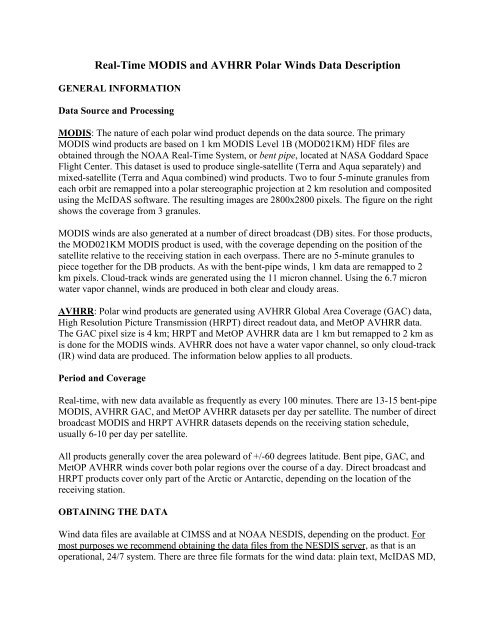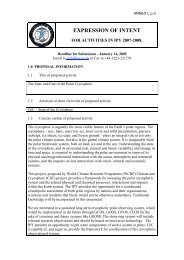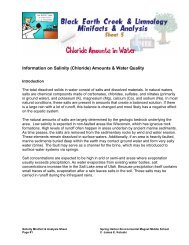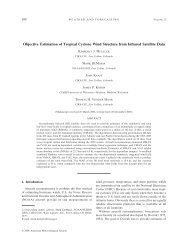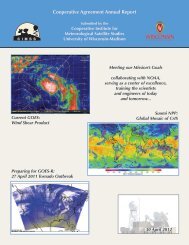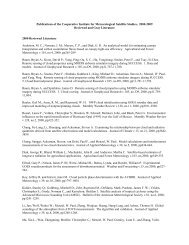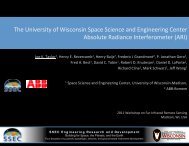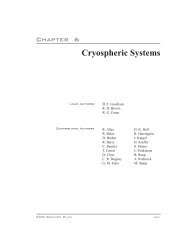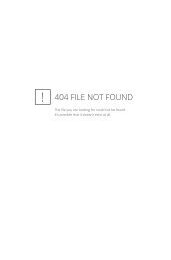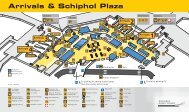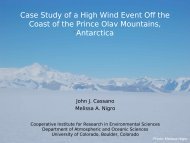here as a PDF file - Polar Satellite Meteorology at CIMSS
here as a PDF file - Polar Satellite Meteorology at CIMSS
here as a PDF file - Polar Satellite Meteorology at CIMSS
Create successful ePaper yourself
Turn your PDF publications into a flip-book with our unique Google optimized e-Paper software.
Real-Time MODIS and AVHRR <strong>Polar</strong> Winds D<strong>at</strong>a DescriptionGENERAL INFORMATIOND<strong>at</strong>a Source and ProcessingMODIS: The n<strong>at</strong>ure of each polar wind product depends on the d<strong>at</strong>a source. The primaryMODIS wind products are b<strong>as</strong>ed on 1 km MODIS Level 1B (MOD021KM) HDF <strong>file</strong>s areobtained through the NOAA Real-Time System, or bent pipe, loc<strong>at</strong>ed <strong>at</strong> NASA Goddard SpaceFlight Center. This d<strong>at</strong><strong>as</strong>et is used to produce single-s<strong>at</strong>ellite (Terra and Aqua separ<strong>at</strong>ely) andmixed-s<strong>at</strong>ellite (Terra and Aqua combined) wind products. Two to four 5-minute granules fromeach orbit are remapped into a polar stereographic projection <strong>at</strong> 2 km resolution and compositedusing the McIDAS software. The resulting images are 2800x2800 pixels. The figure on the rightshows the coverage from 3 granules.MODIS winds are also gener<strong>at</strong>ed <strong>at</strong> a number of direct broadc<strong>as</strong>t (DB) sites. For those products,the MOD021KM MODIS product is used, with the coverage depending on the position of thes<strong>at</strong>ellite rel<strong>at</strong>ive to the receiving st<strong>at</strong>ion in each overp<strong>as</strong>s. T<strong>here</strong> are no 5-minute granules topiece together for the DB products. As with the bent-pipe winds, 1 km d<strong>at</strong>a are remapped to 2km pixels. Cloud-track winds are gener<strong>at</strong>ed using the 11 micron channel. Using the 6.7 micronw<strong>at</strong>er vapor channel, winds are produced in both clear and cloudy are<strong>as</strong>.AVHRR: <strong>Polar</strong> wind products are gener<strong>at</strong>ed using AVHRR Global Area Coverage (GAC) d<strong>at</strong>a,High Resolution Picture Transmission (HRPT) direct readout d<strong>at</strong>a, and MetOP AVHRR d<strong>at</strong>a.The GAC pixel size is 4 km; HRPT and MetOP AVHRR d<strong>at</strong>a are 1 km but remapped to 2 km <strong>as</strong>is done for the MODIS winds. AVHRR does not have a w<strong>at</strong>er vapor channel, so only cloud-track(IR) wind d<strong>at</strong>a are produced. The inform<strong>at</strong>ion below applies to all products.Period and CoverageReal-time, with new d<strong>at</strong>a available <strong>as</strong> frequently <strong>as</strong> every 100 minutes. T<strong>here</strong> are 13-15 bent-pipeMODIS, AVHRR GAC, and MetOP AVHRR d<strong>at</strong><strong>as</strong>ets per day per s<strong>at</strong>ellite. The number of directbroadc<strong>as</strong>t MODIS and HRPT AVHRR d<strong>at</strong><strong>as</strong>ets depends on the receiving st<strong>at</strong>ion schedule,usually 6-10 per day per s<strong>at</strong>ellite.All products generally cover the area poleward of +/-60 degrees l<strong>at</strong>itude. Bent pipe, GAC, andMetOP AVHRR winds cover both polar regions over the course of a day. Direct broadc<strong>as</strong>t andHRPT products cover only part of the Arctic or Antarctic, depending on the loc<strong>at</strong>ion of t<strong>here</strong>ceiving st<strong>at</strong>ion.OBTAINING THE DATAWind d<strong>at</strong>a <strong>file</strong>s are available <strong>at</strong> <strong>CIMSS</strong> and <strong>at</strong> NOAA NESDIS, depending on the product. Formost purposes we recommend obtaining the d<strong>at</strong>a <strong>file</strong>s from the NESDIS server, <strong>as</strong> th<strong>at</strong> is anoper<strong>at</strong>ional, 24/7 system. T<strong>here</strong> are three <strong>file</strong> form<strong>at</strong>s for the wind d<strong>at</strong>a: plain text, McIDAS MD,
and BUFR. Not all products are available in all form<strong>at</strong>s. NESDIS d<strong>at</strong>a are BUFR only. Theavailability of products and <strong>file</strong> form<strong>at</strong>s is given in the table below.Product/Source <strong>CIMSS</strong> NESDIS ServerMODIS single-s<strong>at</strong>ellite, bentpipetext, MD BUFR, text, MD 1, 2, GTSMODIS mixed-s<strong>at</strong>ellite, bentpipetext (experimental) - (expected l<strong>at</strong>e 2011) 3MODIS direct broadc<strong>as</strong>t text, MD, BUFR - 4, 5, EUMETC<strong>as</strong>tAVHRR GAC text, MD, BUFR BUFR, text, MD 6, GTSAVHRR HRPT text, MD, BUFR - 7AVHRR MetOp text, MD, BUFR - 6, GTSHistorical AVHRR text, MD, BUFR - 8Servers referenced in table above (all anonymous FTP):1. MODIS Bent-pipe from <strong>CIMSS</strong>: ftp.ssec.wisc.edu in velden/winds/terra andvelden/winds/aqua. Mirrored on str<strong>at</strong>us.ssec.wisc.edu in pub/winds/rts/terra andpub/winds/rts/aqua.2. MODIS Bent-pipe from NESDIS oper<strong>at</strong>ions: The BUFR <strong>file</strong>s are ons<strong>at</strong>epsanone.nesdis.noaa.gov in pub/bufr/modis_winds. The text and MD <strong>file</strong>s are onftp.ssec.wisc.edu in velden/winds/terra/NOAA and velden/winds/aqua/NOAA, <strong>as</strong> well <strong>as</strong> onstr<strong>at</strong>us.ssec.wisc.edu in pub/winds/rts/terra/NOAA and pub/winds/rts/aqua/NOAA.3. MODIS mixed-s<strong>at</strong>ellite: (available on request)4. MODIS DB BUFR: str<strong>at</strong>us.ssec.wisc.edu in pub/winds/bufr. The <strong>file</strong> name extensions are:PBRW - Barrow (AVHRR), PAFA – Fairbanks, ENTC - Tromso, EFSO - Sodankyla, MCMR– McMurdo, EGAR - Rothera.5. MODIS and AVHRR DB plain text and MD: str<strong>at</strong>us.ssec.wisc.edu in pub/winds/mcmurdo,pub/winds/tromso, pub/winds/sodanklya, pub/winds/fairbanks, pub/winds/barrow,pub/winds/rothera.6. AVHRR GAC and MetOP from NESDIS oper<strong>at</strong>ions and <strong>CIMSS</strong>: The NESDIS oper<strong>at</strong>ionalBUFR <strong>file</strong>s are on s<strong>at</strong>epsanone.nesdis.noaa.gov in pub/bufr/avhrr_winds. The <strong>CIMSS</strong>winds are on ftp.ssec.wisc.edu in velden/winds/avhrr/, w<strong>here</strong> is N15, N16, N17,N18, or METOP. Mirrored on str<strong>at</strong>us.ssec.wisc.edu in pub/winds/avhrr/.7. AVHRR HRPT: str<strong>at</strong>us.ssec.wisc.edu in pub/winds/barrow, pub/winds/rothera (text andMD), and pub/winds/bufr (BUFR).8. Historical AVHRR: str<strong>at</strong>us.ssec.wisc.edu in pub/winds/histavhrr//MD|<strong>as</strong>ci|bufr.Direct broadc<strong>as</strong>t MODIS winds from Tromso and McMurdo are also available on EUMETC<strong>as</strong>t.NESDIS MODIS and AVHRR winds are broadc<strong>as</strong>t over the GTS.Archived Winds: Most of the wind <strong>file</strong>s are archived. They are available onstr<strong>at</strong>us.ssec.wisc.edu in pub/winds/archive/. Unfortun<strong>at</strong>ely, the subdirectorystructures are not internally consistent <strong>at</strong> this time.
FILE FORMATS AND NAMESText FilesAt <strong>CIMSS</strong>/SSEC, the text and MD <strong>file</strong>s are organized by wind set number. Since t<strong>here</strong> are 14-15orbits/day, we get 12-13 wind sets/day (overlapping triplets, but not crossing the day boundary).If wind sets are reprocessed, the <strong>file</strong>s are overwritten.The text <strong>file</strong>s are named:QIyyyyddd.nn.pp.gzw<strong>here</strong>yyyy = yearddd = day of yearnn = 01 to 13 indic<strong>at</strong>ing wind set of the daypp = NP or SP indic<strong>at</strong>ing north or south poleFor example:QI2002183.01.NP.gzis the first wind set from day 2002183 over the North Pole.The d<strong>at</strong>a contained in the text <strong>file</strong> are of the form:w<strong>here</strong>type s<strong>at</strong> day hms l<strong>at</strong> lon pre spd dir rff qi tempWV MODIS 20021113 1530 82.78 -101.92 450 19.8 164 59.25 .83 234.6WV MODIS 20021113 1530 86.73 -127.92 450 24.0 220 73.81 .71 235.7WV MODIS 20021113 1530 82.24 -98.92 462 14.9 153 54.79 .83 234.6type: WV - w<strong>at</strong>er vapor (6.7 µm); IR - infrared (11 µm)s<strong>at</strong>: MODIS [all from MODIS instrument]day: yyyymmdd: yyyy - year, mm - month of year; dd - day of monthhms: hhmm: hour and minute of the middle image [GMT]l<strong>at</strong>: l<strong>at</strong>itude (positive North)lon: longitude (positive West) Note: E<strong>as</strong>t longitudes are neg<strong>at</strong>ive.pre: pressure level of wind [hPa]spd: wind speed in m/sdir: wind directionrff: <strong>CIMSS</strong> recursive filter quality control valueqi: EUMETSAT control valuetemp: IR or WV brightness temper<strong>at</strong>ureMcIDAS MD FilesThe MD <strong>file</strong>s are named:
w<strong>here</strong>:MDXXxxnn.yyyyddd.pp.gzxxnn = 2001 to 2013 [NP]xxnn = 2101 to 2113 [SP]and the l<strong>as</strong>t 2 digits are the wind set number <strong>as</strong> above.For example: MDXX2001.2002183.NP.gz is the first wind set from day 2002183 over the NorthPole.BUFR FilesThe MODIS direct broadc<strong>as</strong>t and AVHRR winds are also available in BUFR form<strong>at</strong>. TheMODIS bent pipe winds are not available in BUFR. Standard BUFR decoders may work. OurBUFR decoder is available via anonymous FTP fromstr<strong>at</strong>us.ssec.wisc.eduin the /pub/winds/bufr_software directory. Pre-compiled versions for Linux, Mac OS X, andWindows are available.The NESDIS BUFR <strong>file</strong> naming convention is:Aqua Files: s<strong>at</strong>wnd.bufrxxxx.aqua.Dyyddd.Thh:mm:ssZTerra Files: s<strong>at</strong>wnd.bufrxxxx.terra.Dyyddd.Thh:mm:ssZw<strong>here</strong>:xxxx = cdft for IR cloud-drift windsxxxx = wvap for w<strong>at</strong>er vapor windsyy = yearddd = julian dayhh,mm,ss = hour, minute, second (system time)The <strong>CIMSS</strong> BUFR <strong>file</strong> naming convention is similar:s<strong>at</strong>wnd.bufrxxxx..Dyyddd.ThhmmZ.w<strong>here</strong>:xxxx = cdft for IR cloud-drift windsxxxx = wvap for w<strong>at</strong>er vapor winds = the s<strong>at</strong>ellite: aqua, terra, N18, etc.yy = yearddd = julian dayhhmm = hour, minute
= optional (including the period) direct broadc<strong>as</strong>t site indic<strong>at</strong>or: PBRW - Barrow(AVHRR), PAFA – Fairbanks, ENTC - Tromso, EFSO - Sodankyla, MCMR –McMurdo, EGAR – Rothera.GTSAs indic<strong>at</strong>ed in the table above, some d<strong>at</strong>a are available on the GTS. Here is the WMO headerlist of MODIS and AVHRR GAC winds:AQUA_IR: JICX01 KNES YYGGggTERRA_IR: JBCX01 KNES YYGGggAQUA_WV: JLCX01 KNES YYGGggTERRA_WV: JFCX01 KNES YYGGggNOAA-15:NOAA-16:NOAA-17:NOAA-18:NOAA-19:METOP:JCVX91 KNES YYGGggJCVX92 KNES YYGGggJCVX93 KNES YYGGggJCVX94 KNES YYGGggJCVX95 KNES YYGGggJCVX97 KNES YYGGggUSAGE POLICYThe d<strong>at</strong>a are free, w<strong>here</strong> "free" means th<strong>at</strong> they are available <strong>at</strong> no cost. "Free" does not meanunconditional use. In order to ensure th<strong>at</strong> they are being used <strong>as</strong> intended, ple<strong>as</strong>e send us a notewith a brief description of your applic<strong>at</strong>ion. While we have tried to make clear their limit<strong>at</strong>ions,t<strong>here</strong> will almost certainly be some applic<strong>at</strong>ions th<strong>at</strong> we have not addressed, and for which thed<strong>at</strong>a or programs are not well-suited. Additionally, if these d<strong>at</strong>a will play a significant role in ajournal public<strong>at</strong>ion, ple<strong>as</strong>e consider including the developers <strong>as</strong> co-authors.CONTACTSIf you have any questions about the d<strong>at</strong>a or project, contact:Jeff Key: jeff.key@ssec.wisc.eduDave Santek: dave.santek@ssec.wisc.eduChris Velden: chris.velden@ssec.wisc.edu


